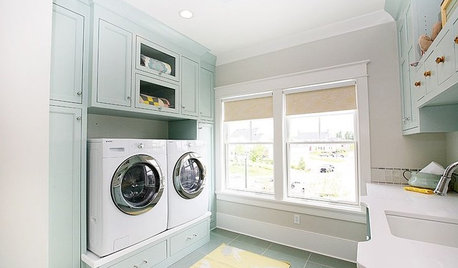water mixer in newer washers...
ctgardengirl
12 years ago
Related Stories

SAVING WATER11 Ways to Save Water at Home
Whether you live in a drought-stricken area or just want to help preserve a precious resource, here are things you can do to use less water
Full Story
GREEN BUILDINGWater Sense for Big Savings
Keep dollars in your pocket and preserve a precious resource with these easy DIY strategies
Full Story
GREEN DECORATINGEasy Green: Big and Small Ways to Be More Water-Wise at Home
These 20 tips can help us all make the best use of a precious resource. How do you save water in summer?
Full Story
GREAT HOME PROJECTSHow to Switch to a Tankless Water Heater
New project for a new year: Swap your conventional heater for an energy-saving model — and don’t be fooled by misinformation
Full Story
REMODELING GUIDESContractor Tips: Advice for Laundry Room Design
Thinking ahead when installing or moving a washer and dryer can prevent frustration and damage down the road
Full Story
EARTH DAYGrow a Beautiful Garden With Ecofriendly Greywater
Reducing home water waste means lower bills and a healthier planet. Here's how to set up a greywater home irrigation system that can help
Full Story
LAUNDRY ROOMS8 Tips for Cleaner, Greener Laundry
Let go of harsh chemicals and hot water, and go easy on your clothes, your wallet and the planet
Full Story
HOUSEKEEPINGDishwasher vs. Hand-Washing Debate Finally Solved — Sort Of
Readers in 8 countries weigh in on whether an appliance saves time, water and sanity or if washing by hand is the only saving grace
Full Story
HOUSEKEEPINGEasy Green: Steam Cleaners for a Chemical-Free Sparkle
Deep clean and sanitize by harnessing high-temperature water for floors, curtains and clothes as immaculate as they are healthy
Full Story
HOUSEKEEPINGThe Quick and Easy Way to Clean a Microwave
All you need is water and a couple of other natural ingredients to get your appliance sparkling and smelling fresh again
Full Story








dadoes
patrick_808
Related Professionals
Palmetto Estates Kitchen & Bathroom Designers · Key Biscayne Kitchen & Bathroom Remodelers · Palestine Kitchen & Bathroom Remodelers · Christiansburg Cabinets & Cabinetry · Drexel Hill Cabinets & Cabinetry · White Center Cabinets & Cabinetry · Galena Park Custom Closet Designers · Springfield Custom Closet Designers · Des Plaines Flooring Contractors · Eastvale Flooring Contractors · Fishers Flooring Contractors · Manteca Flooring Contractors · Nashville Flooring Contractors · Spokane Flooring Contractors · Westerville Flooring Contractorsdadoes
DrPepperTech
asolo
DrPepperTech
asolo
DrPepperTech
asolo
dadoes
caryscott
asolo
itguy08
asolo
pcpr_gw
suburbanmd
caryscott
asolo
caryscott
suburbanmd
asolo
pcpr_gw
itguy08
suburbanmd
pcpr_gw
dualref
cynic